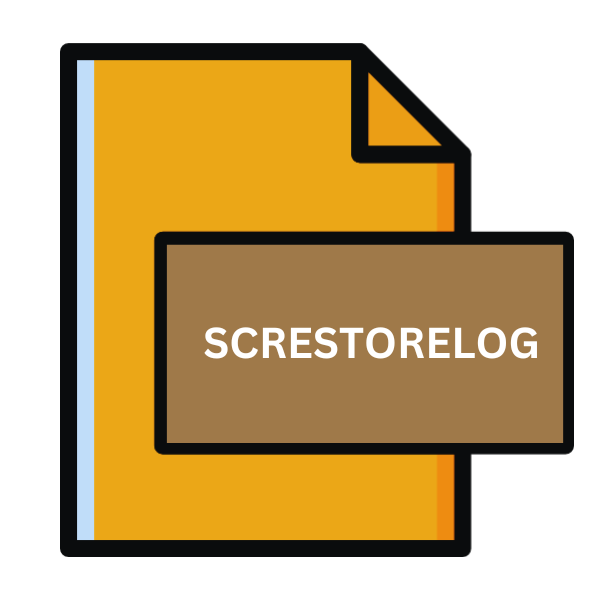.SCRESTORELOG File Extension

Spring Cleaning Restore Log
| Developer | Smith Micro |
| Popularity | |
| Category | Data Files |
| Format | .SCRESTORELOG |
| Cross Platform | Update Soon |
What is an SCRESTORELOG file?
In the digital age, where data is abundant and indispensable, managing files efficiently is paramount. Among the myriad of file extensions, the .SCRESTORELOG file stands out as a vital component of Spring Cleaning software, designed to organize and restore files effectively.
In this detailed article, we delve into the origins, history, technical specifications, advantages, disadvantages, and methods to open and convert .SCRESTORELOG files across various platforms.
More Information.
The concept of Spring Cleaning software emerged from the necessity to streamline file management processes on personal computers.
Smith Micro Software introduced Spring Cleaning to address the growing concerns of cluttered hard drives and inefficient file organization.
With its inception, .SCRESTORELOG files became integral to the restoration process, ensuring transparency and accountability in file management tasks.
Origin Of This File.
The .SCRESTORELOG file extension is primarily associated with Spring Cleaning software, a popular utility tool developed by Smith Micro Software.
Spring Cleaning aims to declutter and optimize computer systems by organizing files, removing duplicates, and restoring misplaced items efficiently.
The .SCRESTORELOG file serves as a log file generated during the restoration process, documenting actions taken and providing a reference point for users.
File Structure Technical Specification.
.SCRESTORELOG files are structured in a readable format, typically containing detailed information about restored files.
The technical specifications may vary depending on the version of Spring Cleaning software used. Common elements found within .SCRESTORELOG files include timestamps, file paths, actions performed (such as restore, delete, or move), and any relevant notes or comments.
How to Convert the File?
- Manual Extraction: Open the .SCRESTORELOG file in a text editor, copy relevant data, and paste it into a spreadsheet for formatting.
- Custom Scripting: Develop a script in Python or other languages to automate data extraction from .SCRESTORELOG files into desired formats.
- Online Conversion Tools: Explore online services capable of converting text-based files; upload the .SCRESTORELOG, select the output format (e.g., CSV), and download the converted file.
- Third-Party Software: Look for specialized software tools designed for parsing and converting log files; ensure compatibility and reliability.
- Consult IT Professionals: Seek assistance from IT experts or developers for complex conversion tasks or critical data handling within .SCRESTORELOG files.
- Verify Accuracy: Regardless of the method used, verify the accuracy of the converted data and ensure compatibility with the target software or platform.
- Consider Complexity and Importance: Assess the complexity and importance of the conversion task before selecting a method; prioritize accuracy and data integrity.
Advantages And Disadvantages.
Advantage:
- Efficient File Restoration: .SCRESTORELOG files facilitate quick and accurate restoration of files to their original locations, minimizing data loss and preserving file integrity.
- Documentation and Accountability: By documenting each restoration action, .SCRESTORELOG files enhance transparency and accountability in file management processes.
- Organizational Aid: Users can review .SCRESTORELOG files to track changes, identify misplaced items, and optimize file organization strategies effectively.
Disadvantage:
- Compatibility Issues: .SCRESTORELOG files may not be compatible with all file management software, limiting their usability outside of Spring Cleaning.
- Dependency on Spring Cleaning: Users relying solely on .SCRESTORELOG files for file restoration may encounter difficulties if Spring Cleaning software becomes obsolete or unsupported.
- Limited Functionality: While .SCRESTORELOG files serve their intended purpose well, they lack the versatility and functionality of more widely-used file formats.
How to Open SCRESTORELOG?
Open In Windows
Use Spring Cleaning software or any text editor like Notepad or Notepad++ to directly open .SCRESTORELOG files on Windows.
Open In Linux
Use text editors like Vim or Nano to open .SCRESTORELOG files in Linux distributions.
Open In MAC
Use TextEdit or any text editor available on macOS to open .SCRESTORELOG files.
Open In Android
Transfer .SCRESTORELOG files to a compatible text editor app such as QuickEdit or Jota Text Editor for viewing on Android devices.
Open In IOS
Transfer .SCRESTORELOG files to a compatible text editor app such as Textastic or TextEdit for viewing on iOS devices.
Open in Others
Use cross-platform text editors like Sublime Text or Atom for opening .SCRESTORELOG files on various operating systems other than Windows, Linux, macOS, Android, or iOS. These editors offer compatibility across multiple platforms.













